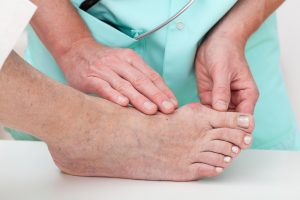 You’re riding down Oso Parkway or La Paz Road behind a slow-moving car, and take a look in the rearview mirror, measuring your chances of pulling out and passing it. We like to go through life with as few bumps as possible, so we constantly measure risks as we make our decisions. Guess what? You should do that with your feet too. Determining your risk factors for bunions can help you make some decisions that could head off this painful bump on your foot.
You’re riding down Oso Parkway or La Paz Road behind a slow-moving car, and take a look in the rearview mirror, measuring your chances of pulling out and passing it. We like to go through life with as few bumps as possible, so we constantly measure risks as we make our decisions. Guess what? You should do that with your feet too. Determining your risk factors for bunions can help you make some decisions that could head off this painful bump on your foot.
There are five main factors that make it more likely that you might develop this deformity in your big toe:
- An inflammatory joint disease like arthritis
- An abnormal foot function due to foot structure (e.g., overpronation due to low arches) or to neuromuscular diseases
- Occupational hazards, including stress on the toes, long hours on your feet, and work boots (especially for ballet dancers, baseball catchers, nurses, teachers, police officers, construction workers, etc.)
- Limb inequality, where the longer leg compensates by adopting an abnormal gait
- Improper footwear (too small, too pointed, heels too high, etc.) that squeezes the toes
The first four you may not have much control over. You don’t go out and decide to get arthritis, your foot structure and limb length are inherited, and you may not be able to find other work. However, your shoe choice is under your control, so make it wisely. Choose a pair with good support for your arch, plenty of room for toes to lie straight and flat, and heels 2 inches or less.
If you have any of the risk factors for bunions and notice a red spot on your big toe when you take off your shoes, come in to our office for a foot check. We can evaluate what is going on and advise you on the best shoe styles, or fit you with custom orthotics to correct a gait imbalance. We can also give you tips for handling arthritis in your feet or share hints to compensate for foot stress on the job.
Contact Southern California Foot & Ankle Specialists in Ladera Ranch, CA today by dialing (949) 364-9255 (WALK) or connecting with us through our website. We’ll help you measure your risk for bunions and find the best ways to prevent them.
